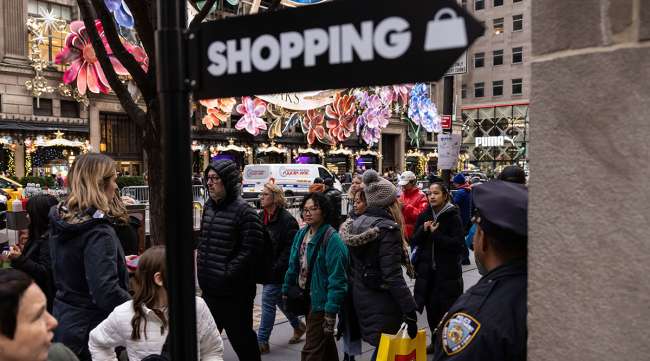Retail Sales Rise 0.3% in November as Holiday Rush Begins

[Stay on top of transportation news: Get TTNews in your inbox.]
NEW YORK — Americans picked up their spending from October to November unexpectedly as the unofficial holiday season kicked off, underscoring the power of shoppers despite elevated prices.
Retail sales rose 0.3% in November from October, when sales were down a revised 0.2% according to the Commerce Department on Dec. 14. Sales were expected to decline again in November due to myriad issues, including uncertainty over the economy. Sales rose 0.6%, excluding car and gas sales.
As they have been doing for much of the year, American consumers, a huge engine for economic growth in the U.S., hit the stores, shopped online or went out to restaurants.
Business at restaurants rose 1.6%, while sales at furniture stores rose 0.9%. Online sales rose 1%. Business at clothing and accessories stores were up 0.6%. Electronic and appliance sales, however, fell 1.1%. Sales at department stores fell 2.5%. The figures aren’t adjusted for inflation.
The urge to spend for Americans appears to have some running room, even after a blowout summer. Consumer spending jumped in the July-September quarter. Economists have been expecting spending to slow in the final three months of the year as credit card debt and delinquencies rise, and savings fall.
“While consumers continue to face hurdles from higher borrowing costs, tighter credit conditions and elevated prices, a still-strong labor market, a positive trend in incomes and an easing in price pressures should keep spending and growth positive for now,” wrote Rubeela Farooqi, chief U.S. economist for High Frequency Economics.
U.S. employment data in early December showed that employers added 199,000 jobs in November and the unemployment rate declined to 3.7%. Inflation has plummeted in little over a year from a troubling 9.1%, to 3.2%. While that’s still above the desired level, the economy by most counts is likely to avoid the recession many economists had feared, a potential side effect of U.S. attempts to cool inflation.
Yet people remain gloomy, according to the University of Michigan’s Index of Consumer Sentiment. The preliminary December figures issued Dec. 8 showed moods have improved as more people see inflation cooling.
Moreover, many economists worry about how shoppers are paying for all the stuff. Stores have been discounting holiday merchandise earlier and heavier. Mark Cohen, director of retail studies at Columbia Business School, believes that stores have been intensifying their discounting to get shoppers to buy.
Ted Rossman, senior industry analyst at Bankrate, noted that credit card balances and rates are at all-time highs.
“It feels like the holiday debt hangover could be particularly nasty this year,” he said.
ERoad's Craig Marris gives advice on carving out a practical, effective road map to a greener and more efficient fleet. Tune in above or by going to RoadSigns.ttnews.com.
The strong retail numbers Dec. 14 were particularly surprising given some of the news coming from retailers themselves.
In the most recent quarter, retailers including Walmart and Macy’s said that shoppers were being more selective in what they were buying as the holiday shopping season approached.
Walmart attracted shoppers looking for deals, but its expectations going forward were muted. Sales at Target slid even though the chain did better than many industry watchers had expected.
Sales fell at Home Depot as well, as customers put off home renovations and purchases of big-ticket items like appliances and other goods often bought with credit cards.
Yet the National Retail Federation, the nation’s largest retail trade group, still expects shoppers will spend more during the 2023 winter holidays than last year.
The group forecast in November that U.S. holiday sales will rise 3% to 4% for November through December. That is slower than the 5.4% growth over the same period a year ago, but more consistent with the average annual holiday increase of 3.6% from 2010 to pre-pandemic 2019.
Merlin Tavares, father of five, ages 2 to 22, was at the Camp toy store in Manhattan earlier this week. He said that still-high inflation was forcing him to start earlier than last year to buy holiday gifts so he could spread out the bills.
“Every year I tell myself I’m going to start early and it doesn’t happen,” said Tavares. ”But this year, I had to make sure that I actually get this holiday shopping started early so I can,be able to afford everything that I have to buy.”
Want more news? Listen to today's daily briefing above or go here for more info
Black Friday was expected to again be the busiest day of the season even as sales have become more spread out. But retailers still have six of the top 10 busiest days of the season ahead of them, including Dec. 26, according to Sensormatic Solutions, which tracks store traffic. On average, the top 10 busiest shopping days in the U.S. account for roughly 40% of all holiday retail traffic, it said.
Ethan Chernofsky, vice president of marketing at Placer.ai, which tracks people’s movements based on cellphone usage, noted that Black Friday traffic was strong. But then there’s group of shoppers that will wait for deals closer to the holiday.
Those shoppers are “willing to play that game, a game of chicken until the last possible minute,” he said.
The government’s monthly retail sales report offers only a partial look at consumer spending; it doesn’t include many services, including health care, travel and hotel lodging.
— AP Economics writer Chris Rugaber in Washington and AP vice producer Joseph B. Frederick in New York contributed to this report.





